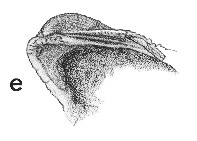
Revised descriptions of New Zealand Cenozoic Mollusca from Beu and Maxwell (1990)

 | Revised descriptions of New Zealand Cenozoic Mollusca from Beu and Maxwell (1990) | 
|
  (Pl. 23d): holotype, Pakaurangi Point, Kaipara Harbour, Northland, Otaian or Altonian (TM2122, GNS) |
  (Pl. 23e): holotype, Pakaurangi Point, Kaipara Harbour, Northland, Otaian or Altonian (TM2122, GNS) |
Beu & Maxwell (1990): Chapter 11; p. 215; pl. 23 d,e.
Synonymy: Mytilus torquatus Marshall 1918, p. 168; Trichomya torquata
Classification: Mytilidae: Mytilinae
Description: Rather small for family (length 20-33 mm), mytiliform, of rather variable shape, many specimens of stepped profile; beaks terminal or subterminal; dorsal margin long, straight, somewhat wing-like in some shells; ventral margin almost straight except for shallow concavity towards anterior end; posterior end subquadrate. Median part of shell strongly inflated from umbones to posterior end, dorsal area distinctly concave, ventral area slightly convex except for concave zone anteriorly. Radial sculpture on median area of low, rounded, bifurcating costae, most of which do not persist to posterior margin but diverge on subdividing and cross the dorsal and ventral areas, covering them with numerous fine, closely spaced costellae. Commarginal sculpture of fine growth ridges between costae and costellae, less distinct distally than proximally. Anterior extremity with a triangular internal plate or septum to house the anterior adductor muscle. Hinge with a few weak tubercular teeth above septum. Ligament groove long, narrow, below dorsal margin. Internal margin crenulate, other internal features not known.
Comparison: Septifer torquatus is easily distinguished from other New Zealand mytilids by its somewhat irregular shape, its squarish posterior end, its well defined dorsal area, its divaricate sculpture, and its internal septum interior to the anterior end, the last being a diagnostic character of the genus. Hormomya (?) willetsi (Pl. 3e) is superficially similar in shape and sculpture but is smaller and apparently lacks an internal septum, although better material is needed to be certain that it is not a species of Septifer. Septifer is widespread in subtropical and tropical seas at the present day, and is also recorded from Te Piki, near East Cape (Richardson 1997, p. 6; S. bryanae (Pilsbry, 1921), MIS 7, c. 220 00 yrs), northern New Zealand (Powell 1979, p . 372) and New South Wales. Other New Zealand records are from the upper Waihao River, South Canterbury (? Mangaorapan) and from the "Fan coral bed" (Duntroonian), Porter River, Castle Hill Basin. As noted above, "Trichomya" huttoni (Duntroonian) probably also belongs in Septifer.
Distribution: Otaian-Waiauan; Pakaurangi Formation, Pakaurangi Point, Kaipara Harbour, Otaian or Altonian (type); Paratoetoe, Parengarenga Harbour; Stillwater Mudstone, Lake Ryan, near Greymouth; Long Beach Shellbed, Clifden; greensand (Waiauan) at base of Late Miocene sequence, Cape Foulwind.
Cite this publication as: "A.G. Beu and J.I. Raine (2009). Revised
descriptions of New Zealand Cenozoic Mollusca from Beu and Maxwell (1990). GNS
Science miscellaneous series no. 27."
© GNS Science, 2009
ISBN
978-0-478-19705-1
ISSN 1177-2441
(Included with a PDF facsimile file
copy of New Zealand Geological Survey Paleontological Bulletin 58 in CD version
from: Publications Officer, GNS Science, P.O. Box 30368 Lower Hutt, New
Zealand)